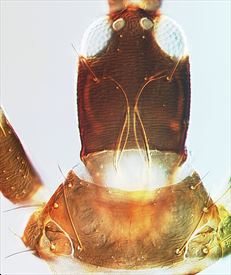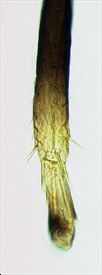Thrips of New Zealand
Distinguishing features
Both sexes fully winged. Body and legs brown, tarsi and fore tibiae yellow also apical third to one half of mid and hind tibiae; antennal segment II brown, III and IV largely yellow, V and VI variably yellow in basal half; major setae dark brown, tergite IX setae paler; fore wing shaded at base then with a longitudinal dark line medially and also shaded around margins. Head longer than wide; maxillary stylets retracted to eyes, close together medially; post ocular setae pointed, almost as long as eyes; mouth cone extending between fore coxae. Antennae 8-segmented; segment III with one slender sense cone, IV with three sense cones; VIII short, slightly narrowed at base. Pronotum with five pairs of long, softly pointed major setae, posteroangulars almost as long as pronotum medially; prosternal basantra not developed, ferna present, mesopresternum lateral triangles sometimes weakly joined medially. Fore tarsus without a tooth. Metanotum with narrow elongate reticulations medially, median setae small and acute. Fore wing parallel-sided, with about 9 duplicated cilia; 3 long softly pointed sub-basal setae sub-equal in length. Tergite IX setae S1 and S2 finely acute, slightly shorter than tube.
Male similar to female; tergite IX setae S2 short and stout; sternite VIII with an extensive pore plate.
Related species
The genus Liothrips comprises about 280 species worldwide, with 30 from southeast Asia being placed into two small sub-genera. Liothrips species are remarkably uniform in body structure, and a particularly high proportion of the described species are known from single samples, or even single individuals. There is thus little support for suggestions concerning host-specificity amongst these species. L. vaneeckei is the only member of the genus recorded from New Zealand. It is usually distinguished from other Liothrips species by the more extensive yellow color of the mid and hind tibiae, as well as the extensively yellow antennal segments.
Biological data
This thrips feeds and breeds on the bulbs of lilies, and less commonly on orchid corms.
Distribution data
Found widely around the world in association with lily bulbs, this species is similarly recorded in New Zealand (WO, WI, (TK) / NC).
Family name
PHLAEOTHRIPIDAE, PHLAEOTHRIPINAE
Species name
Liothrips vaneeckei Priesner
Original name and synonyms
Liothrips vaneeckei Priesner, 1920: 211
References
Mound LA & Walker AK (1986) Tubulifera (Insecta: Thysanoptera). Fauna of New Zealand 10: 1–140.




